ISSN 2348-1196 (print)
International Journal of Computer Science and Information Technology Research ISSN 2348-120X (online) Vol. 9, Issue 4, pp: (4-9), Month: October - December 2021, Available at: www.researchpublish.com

ISSN 2348-1196 (print)
International Journal of Computer Science and Information Technology Research ISSN 2348-120X (online) Vol. 9, Issue 4, pp: (4-9), Month: October - December 2021, Available at: www.researchpublish.com
Saudi
Aramco, Dhahran, Saudi ArabiaAbstract: This paper will explore the overall concept of Enterprise Risk Management (ERM) framework, and the journey undertaken to manage and eliminate the level of risks in an organization.
Keywords: Risk, Enterprise Risk Management (ERM) Framework, Objectives, Control Framework, Risk Assessment, Six Step Risk Management Process, OE Model, OE Risk Management Process.
Risk is a future event with the ability to impact the organization’s mission, strategic and business plans, projects, routine operations, processes, objectives, assets, reputation or the delivery of stakeholder expectations. Risk management reduces and controls the impact of undesirable events. Applying sound risk-based assessment and management proactively addresses and mitigates business threats.
This is an executive summary of the success story of the execution of Enterprise Risk Management (ERM) Framework in our organization. The execution structure is decentralized where many entities are contributing in the success of the execution and continues improvements. For instance, we have the Corporate ERM Team which is responsible for developing and maintaining ERM Framework to support Business Risk management functions, this include developing the Corporate-level policies, Procedures, Methodologies, Enterprise Risk Management System Support and Training. This team is reporting to the Head of Risk in our organization.
In addition to that, we have executed the Operational Excellence (OE) framework in our organization, The Operational Excellence (OE) is an overarching framework that integrates many existing management systems and best practices to consistently and systematically achieve and sustain industry leading performance in terms of Reliability, Efficiency, Cost Effectiveness, and Profitability The goal of OE is to optimize our Organization’s processes to deliver a more agile, flexible and efficient company. OE framework provide a structured approach to achieve and sustain Excellence in all dayto-day activities in each and every department in our organization.
OE Risk Management (RM) Process document has been developed and added to OE processes Manual to ensure the effective execution of the risk management framework. OE RM process document outlines the minimum expectations for all departments in the organization aligned with the Enterprise ERM Corporate Policy and ERM General Instruction (GI). OE RM Process, used to support ERM activities associated with the Corporate Risk Assessments. The process contains guidance and recommendations on ERM activities that are intended to continuously improve the implementation of the Six Step Risk.
OE Department is the organization responsible to assess all Departments’ compliance with Operational Excellence Risk Management Process as part of the Operational Excellence Corporate Assessment process in addition to that report at least annually to the Head of Risk the systemic gaps and recommendations for corporate wide improvement relevant to Operational Excellence Risk Management Process.
Furthermore, Management and Organization Heads play a key role to ensure the effective implementation of the risk management framework, they are responsible for:
Identify and assess the organization’s major risks and document them in the Risk Management System in accordance with the Six Step Risk Management Process
Review the risks identified by the organization at least quarterly, at least annually, and ensure Risk Owner and Risk Champion assignments are appropriate for the efficient and effective management of the risk.
Escalate risks that the organization determines would benefit from oversight by a higher-level
ISSN 2348-1196 (print)
International Journal of Computer Science and Information Technology Research ISSN 2348-120X (online) Vol. 9, Issue 4, pp: (4-9), Month: October - December 2021, Available at: www.researchpublish.com
Define a treatment strategy and supporting treatment actions, and ensure that they are implemented in a timely manner and reviewed regularly.
Review and approve changes to the organization’s risks documented in the Risk Management System at least quarterly, in line with Business Planning, associated performance reviews and accountability reporting and approve the closure of completed tasks within the Risk Management System.
In this section we will provide some key definitions that will help in understanding the implementation of the Enterprise Risk Management (ERM) framework and Operational Excellence (OE) in our organization.
Enterprise Risk Management (ERM) Framework:
The Enterprise Risk Management (ERM) Framework is a formal system of integrated processes by which risks are identified, reported and managed in a systematic, proactive and coordinated manner across the Organization. It adopts the Defense model in the organization, includes, but is not limited to, risk appetite, risk assessment, and Corporate decision making. The Organization’s ERM Framework follows the “three lines of defense” model. The operating and support organizations form the first line and as risk owners, have primary responsibility for managing risk. The second line of defense comprises the corporate risk management functions that support operating and support organizations, and which are responsible for maintaining the ERM Framework, risk monitoring and reporting. The Internal Audit function, as the third line of defense, provides independent assurance on the effectiveness of risk management and controls.
ERM’s overall objective is to ensure that all types of risks to the achievement of objectives are known and managed effectively and efficiently in line with the Organization’s risk appetite and business strategy.
The Risk Management process covers the department’s objectives, understanding the internal and external context, and preparing a Risk Management Plan. Risks to the organization’s objectives are identified, including causes and consequences, and formulating a Risk Register. Existing controls are identified, analysed and assigned to owners. Subsequently, plans to treat risks in the form of a treatment plan with assigned actions and dates for implementation and periodic monitoring and updates.
ERM’s overall objective is to ensure that all types of risks to the achievement of objectives are known and managed effectively and efficiently in line with the Organization’s risk appetite and business strategy. The Organization’s risk appetite is dynamic and is defined by, and incorporated in policies, systems, and procedures by which the Organization manages the amount and types of risk it is willing to pursue or retain to accomplish its objectives.
Risk assessment is the process of identifying risks and analyzing their potential severity. Within the ERM Framework, risks are assessed formally in numerous contexts using the Six Step Risk Management Process.
The standard process which risks are put into context, identified, analyzed, evaluated, treated and monitored.
Head of Risk:
The Head of Risk is responsible for leading the development of the ERM Framework, and advising management on major risks and their control.
A set of policies, procedures and systems by which the Organization manages a specific type of risk. Typical components include management oversight, policies, responsibilities and authorities, operating standards and procedures, and compliance and assurance processes. The Control Framework should define the risk management and control responsibilities of line management and relevant Risk Management Functions.
ISSN 2348-1196 (print)
International Journal of Computer Science and Information Technology Research ISSN 2348-120X (online) Vol. 9, Issue 4, pp: (4-9), Month: October - December 2021, Available at: www.researchpublish.com
Enterprise Risk Management System:
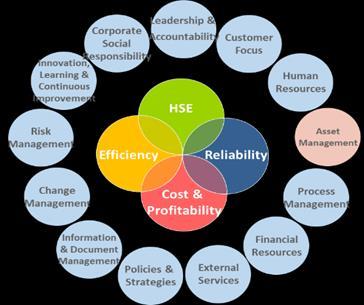
A management information system deployed to support an integrated approach to managing the Organization’s Governance, Risk Management and Compliance (GRC) processes.
Emerging Risk:
A risk of a new type of event for which the consequence and likelihood are uncertain but possibly very severe.
Key Risk Indicator (KRI):
Metric used to provide an indication of changing risk exposures.
Risk Management Function:
An organization is responsible for helping the Organization manage a specific type of risk by developing and maintaining an effective Control Framework, and monitoring risks and compliance.
Risk Owner:
Individual with overall accountability for the management of a risk. Ownership will rest with the head of the organization with primary responsibility for achieving the objective with which the risk is associated.
Risk Register:
A documented register of an organization’s risks maintained in the Risk Management System in accordance with the Six Step Risk Management Process.
Organization Heads:
The Heads of Business Lines, Service Lines, Administrative Areas, General Manager Organizations, and Departments.
Risk Owner:
Individual with overall accountability for the management of a risk. Ownership will rest with the head of the organization with primary responsibility for achieving the objective with which the risk is associated.
Risk Champion:
Individual authorized by the Risk Owner to exercise day-to-day responsibility for the risk’s management, without diminishing the Risk Owner’s ultimate accountability.
OE Components:
OE is composed of four main components that define what it means for an organization and how to make it the Organization way of doing business. The OE components are:
OE Model:
This component defines what any organization within company should do to achieve and sustain excellence. It consists of the organization’s four OE Focus Areas and 13 Enabling Elements (as shown in the figure).
As the name "Enabling Element" implies, these elements are what enable organizations to achieve and sustain excellence. These Enabling Elements are interlinked and all are required. No one single element is adequate on its own. Under each of the 13 Enabling Elements is a set of expectations that describes what needs to be done with respect to the Enabling Element to ensure that it effects the desired change.
ISSN 2348-1196 (print)
International Journal of Computer Science and Information Technology Research ISSN 2348-120X (online) Vol. 9, Issue 4, pp: (4-9), Month: October - December 2021, Available at: www.researchpublish.com
The second OE component is implementation guide, which defines how to achieve and sustain OE through defined processes, procedures and best practices, which are used in a consistent and standardized manner The Implementation Component also identifies techniques and tactics for implementing OE, while at the same time addressing the fundamental cultural and behavioral changes required to produce the right results within every department.
OE Assessment:
This component is designed to periodically assess the level of excellence achieved by each organization within the organization and identify improvement opportunities. The OE assessment process examines the target organization from two perspectives; it examines the performance of the organization in delivering results in the Focus Areas, and it evaluates the organization's ability to sustain performance and drive improvements though the thirteen Enabling Elements.
This component comprises the local and corporate OE entities established to keep the OE process alive and dynamic in addition to supporting OE implementation and assessment activities.
OE Benefits:
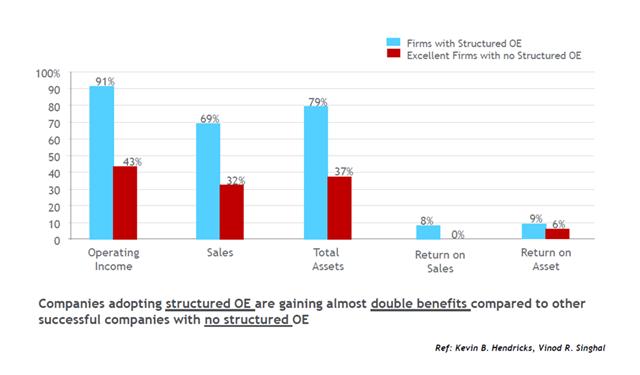
Operational Excellence (OE) offers many benefits including: o Unleash innate potential o Enhance knowledge sharing o Standardize pockets of excellence o Sustain performance improvements o Capture best practices
President’s Operational Excellence Award:
The President’s Operational Excellence Award is given to the top OE performer in the organization. The OE Award process evaluation criteria is based on:
• Verified OE Assessment
• OE Improvements • OE value creation
• Sustainability of results
• Adapting or contributing best practices
The Six-Step Risk Management Process which is the organization’s risk management methodology that are applied to all risk management activities to manage all risks in the organizations. The implementation of Six-Step Risk Management Process is described below.
ISSN 2348-1196 (print)
International Journal of Computer Science and Information Technology Research ISSN 2348-120X (online) Vol. 9, Issue 4, pp: (4-9), Month: October - December 2021, Available at: www.researchpublish.com
Preface:
The ERM Six-Step Process
Methodology based on ISO:31000
4 Important aspects: o Cyclic o Repetitive o Proactive o Embedded
Establish Context:
Understanding the context in which the Six Step Risk Management Process is applied.
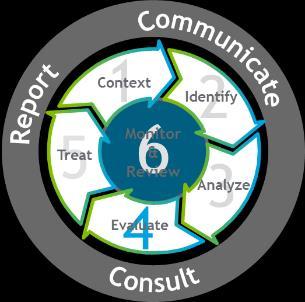
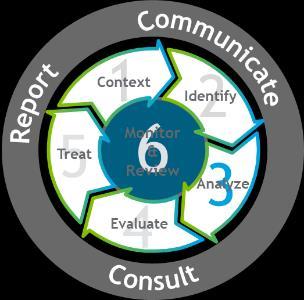

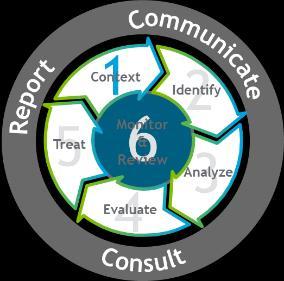
Understanding the internal and external environment associated with the activity
Understanding the objectives of the assessment
Identify:
Identify and articulate key risks
Identify causes and consequences for each risk
Determine risk velocity
Analyze:
Identify and assess individual controls as well the overall control effectiveness
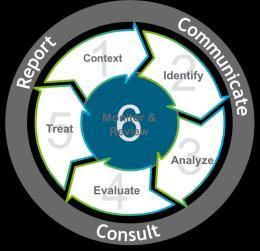
Define and document the Credible Worst-Case Scenario (CWCS)
Use the Risk Assessment Matrix to assess risk likelihood and consequence
o Consequence: The effect on the defined objectives should the risk event occur.
o Likelihood: The effect on the defined objectives should the risk event occur.
o Severity: The effect on the defined objectives should the risk event occur
Modify risk description as needed
Evaluate:
Define and document risk management objectives and strategy
Conduct cost-benefit analysis for planned actions
Evaluate the four TS:
o Terminate: Eliminate the risk (practicality, cost effectiveness, business directive)
o Treat: The application of additional controls and treatments that manage the likelihood and/or the consequence of the risk to a more desirable level
o Tolerate: The existing control framework is adequate.
o Transfer: This involves transferring the risk and its consequence to a third party who is more capable of managing the risk
Risk Escalation
ISSN 2348-1196 (print)
International Journal of Computer Science and Information Technology Research ISSN 2348-120X (online) Vol. 9, Issue 4, pp: (4-9), Month: October - December 2021, Available at: www.researchpublish.com
Treat:
Prepare treatment plan to execute the risk strategy
Consider the risk velocity in developing the treatment plan
Obtain concurrence with task owners on deliverables and due dates
Monitor and report on treatment plans
Adjust the application of the six-step process
Develop and implement KPIs
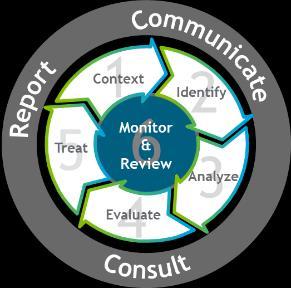
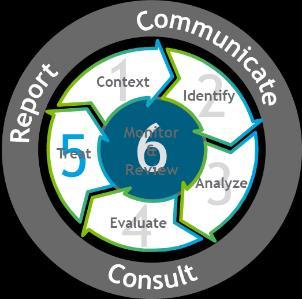
As a result of this successful implementation journey of Enterprise Risk Management and Operational Excellence in our organization, we managed to achieve the third place in the 2017 President’s Operational Excellence Award. Furthermore, our organization is currently performing at an excellent level with a score of 3.02/4.0 in the 2020 Corporate Assessment, exceeding the Corporate's target score of (2.9) Moreover, significant leading performance results have been achieved as a result of successful implementation in terms of Reliability, Efficiency, Cost effectiveness / Profitability, Sustainability, and Safety. Additionally. we were able to proactively control the impact of undesirable events by implementing the appropriate treatments to mitigate the business threats.
[1] Risk Management Corporate Policy, [2] Enterprise Risk Management General Instruction, [3] Six-Step Risk Management Process User Guide, [4] Companies adopting structured OE are gaining almost double benefits compared to other successful companies with no structured OE (Kevin B. Hendricks, Vinod R. Singhal), [5] Operational Excellence Guide